Should you have trees in the chicken run and which ones are the best.
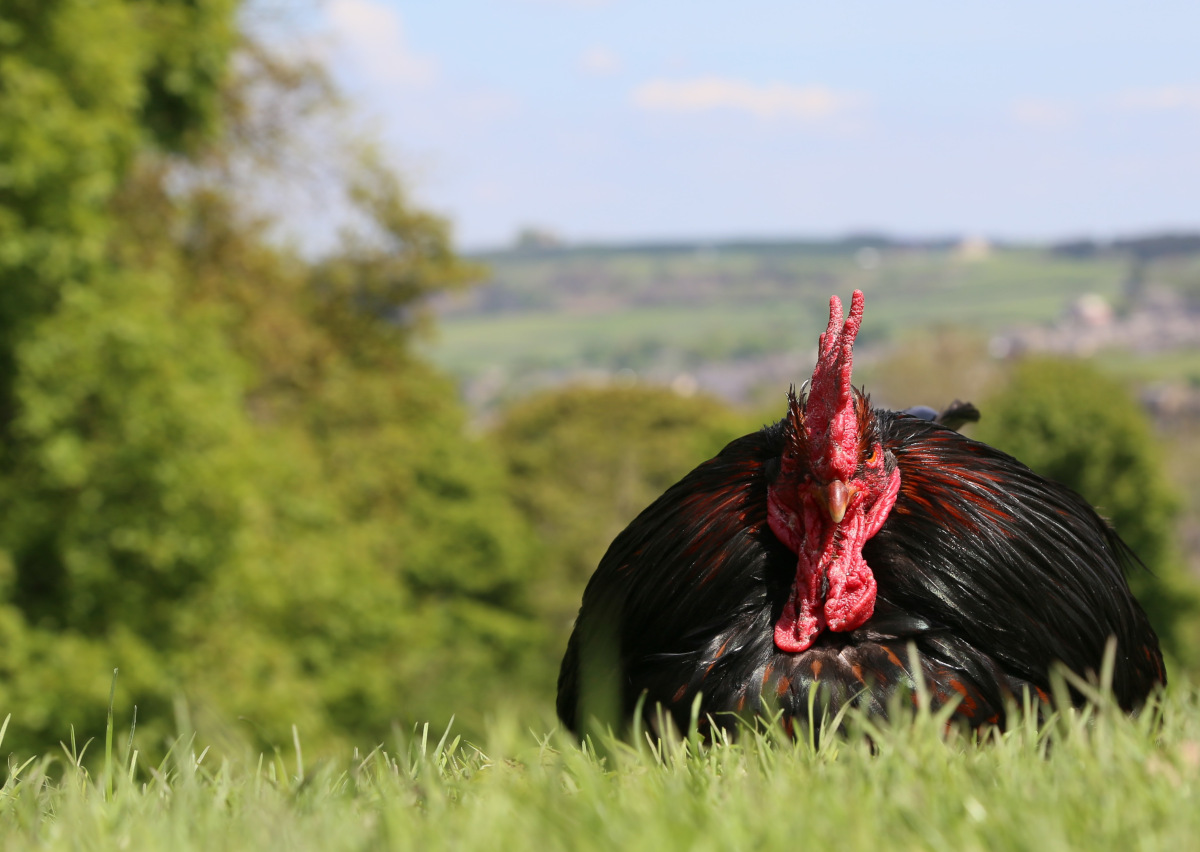
Whenever I have been building or landscaping a chicken run, I have always tried to include trees and shrubs on the land my chickens use.
Trees and shrubs in the chicken run can seem like a double edges sword for the keeper. There are many benefits to the chickens but also the problem of chickens roosting in trees and not going into the coop at night and occasionally using the trees as an escape route.
Below: Here is a group of my Bantam Barnevelders in a breeding pen with two shrubs.
Wild chickens made use of trees for roosting at night and cover from aerial predators during the day.
Some research recently published showed that trees in chicken runs are a haven for wildlife as well.
Can you have a tree in a chicken run?
If you have the space, planting a tree in your chicken run is an excellent idea.
Alternatively you can place your run around a tree so as the hens get all the benefits.
Below: Plants provide shade, shelter and protection for the flock.
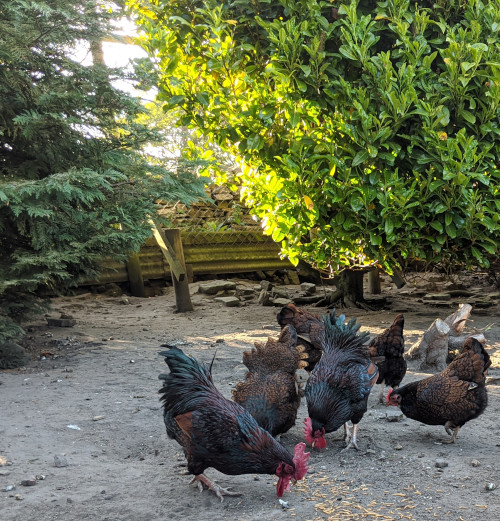
Whatever tree you choose should be big and sturdy enough for the chickens to perch on its branches and not break them. Chickens can and will destroy small trees and shrubs with thin branches.
A chickens natural preference is for a larger tree with plenty of leaves and growth for cover.
Chickens like to stand under trees so one that gives good coverage is best.
This is a list of some of the suitable plants, shrubs and trees for planting in chicken runs and pens:
- Apple or crab apple,
- Pear,
- Medlar,
- Quince,
- kiwi vines,
- Beech,
- Bramble, Blackcurrant, redcurrant, blueberry, goji, juneberry or elderberry,
- Mulberry tree,
- Hawthorn,
- Honey locust,
- Mountain ash or rowan,
- Sea buckthorn,
- Willow,
- Bay tree.
- Pine, cedar or larch, but not the mountain cedar,
- Monkey puzzle.
Chickens and trees are mutually beneficial.
The flock will benefit from the protection of the trees and shrubs and the trees will gain from having the chickens around.
Chickens just love to scratch around and mine spend a lot of their time in the leaf litter under trees as it is full of tasty bugs.
Chickens do three things that help trees to grow:
- They eat the insects and bugs.
- Fertilise the ground with their poop.
- Scratch up the soil and keep the weeds and grass down.
Chickens can and do damage trees although they do not tend to eat them.
Should you plant fruit trees in my chicken Run?
My Uncle always kept his chickens in the orchard on the farm, he reckons it saved him around 20% on his feed bill.
Chickens can eat fallen apples, pears and other fruits.
Below: The best fruit trees to plant for chickens is either an apple or a pear tree. This crab apple produces masses of fruit and shelter.
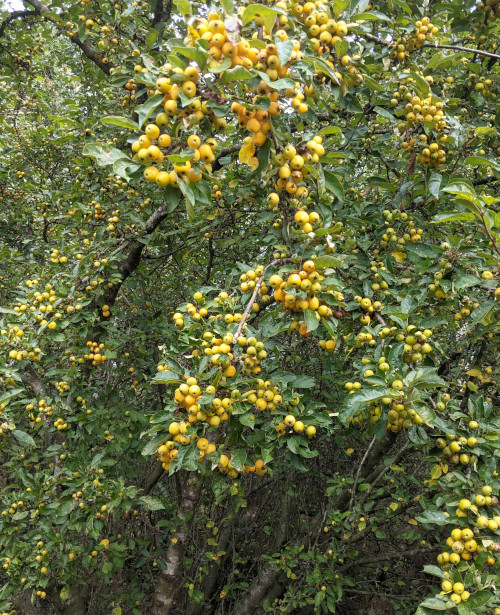
Consider also beech tree, the leaves are edible when young and the nuts are a favourite food.
What about planting herb bushes for chickens?
Chickens can eat herbs but the plants are usually to small and not strong enough to plant around the coop.
Below: I keep my hens well away from my herb garden, they will demolish it in an hour or two.
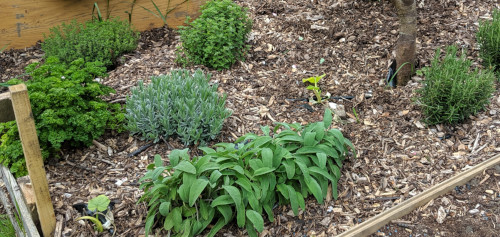
Most herbs with the exception of rosemary are not strong enough to withstand the onslaught of a flock of chickens.
What precaution should you take with trees in the run?
There are three problems with trees in the chicken run:
- The birds might eat something poisonous,
- They may roost in threes at night,
- They might use the trees to escape.
You should make sure the tree is tall enough and you remove the lower branches so that the chickens won't spend the day in the branches or roost in it at night.
The ancestors to chickens, the red jungle fowl roost in trees, it's part of their survival instinct. You may need to clip the feathers of one wing of your chickens until they get used to not going in the trees.
Below: Somebody is about to get their wing feathers clipped.
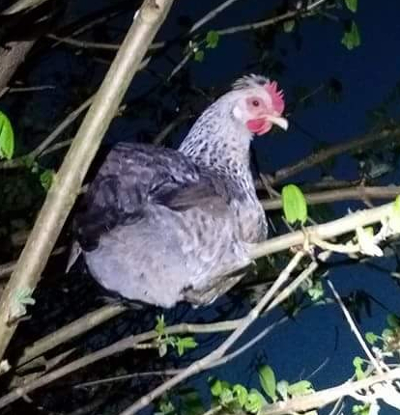
Not all breeds perch on tree branches. Smaller, lighter chickens with longer wings can fly better and larger heavier birds like the Orpington are more likely to stay on the ground
You can't reason with a chickens, so once they start roosting in the trees it can be a problem. You can also use a pole with a hook on the end to grab the bird's leg and pull it off the branch.
Enticing your hens to down at night by providing food and treats before bedtime also works well.
Trees, vines and shrubs to avoid planting in the run:
These are plants or trees that should be avoided:
- Heavy pollen droppers like the Mountain cedar.
- Common holly (Ilex aquifolium).
- Horse Chestnut (Aesculus hippocastanum).
- Common Yew Tree (Taxus baccata).
- Maple, oak, walnut and the trees of the peach, cherry and plum family produce leaves which are toxic when eaten.
- Trees that produce poisonous fruits.
- Trees that have poisonous pits, like the cherry.
- Plants that exude Milky sap.
- Trees and shrubs with naturally shiny leaves.
- Plants that have yellow or white berries.
- Umbrella shaped plants.
I have never seen my chickens eat the leaves of trees but it may be safer to avoid these.
